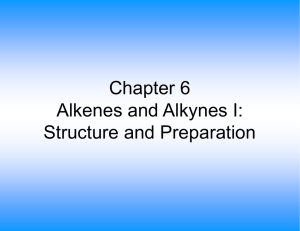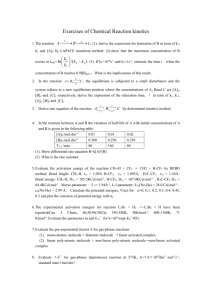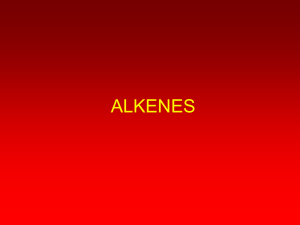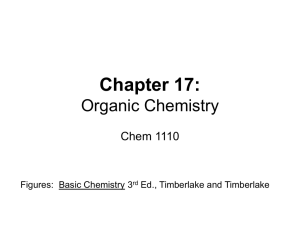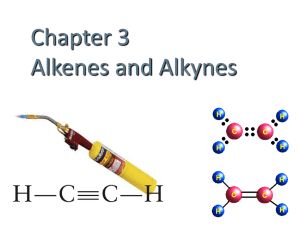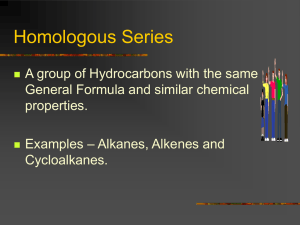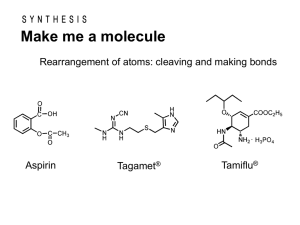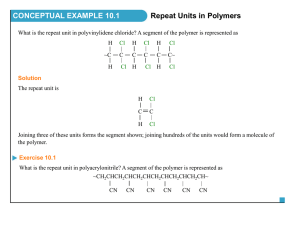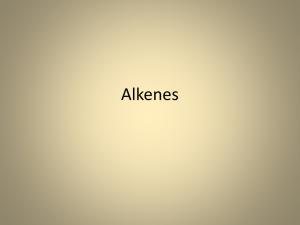Pent 2 ene hbr - A
advertisement
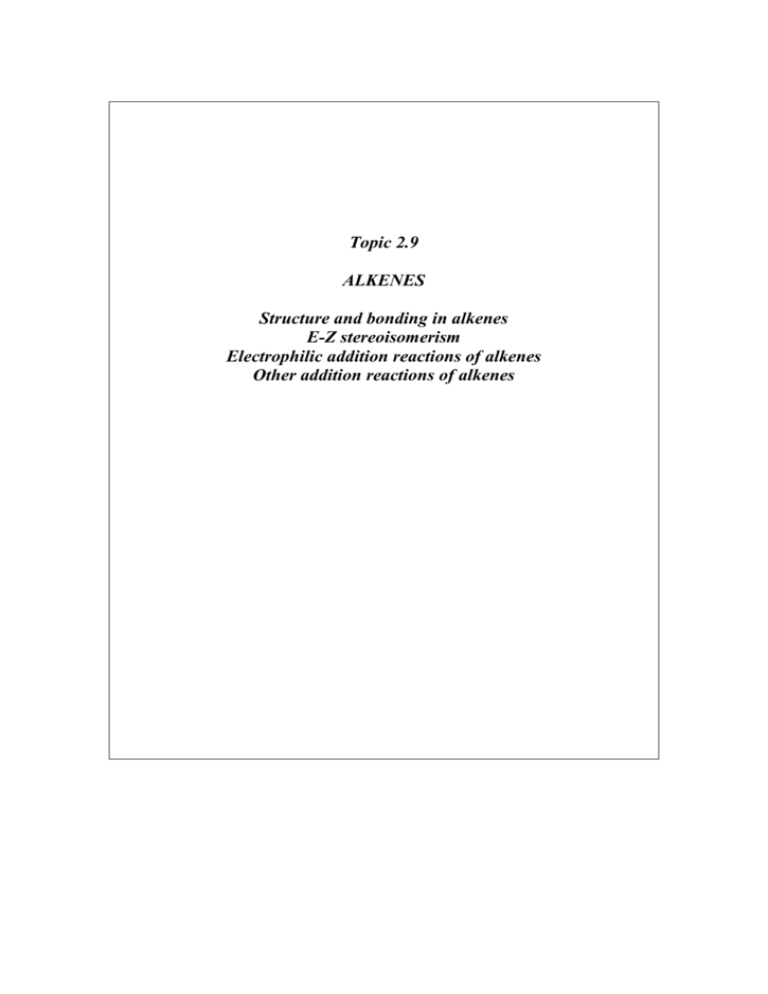
Topic 2.9 ALKENES Structure and bonding in alkenes E-Z stereoisomerism Electrophilic addition reactions of alkenes Other addition reactions of alkenes ALKENES 1. Structure and bonding in alkenes Alkenes are hydrocarbons containing a carbon-carbon double bond. The atoms around the carbon-carbon double bond adopt a planar arrangement and the bond angle is 120o. H H C H C H 2. E-Z stereoisomerism In double bonds, the first bond involves an overlap of atomic orbitals directly in between the nuclei of the two atoms: This is known as a -bond. All single covalent bonds are -bonds. The second bond, however, cannot bond in the same place. Instead two p-orbitals overlap above and below the internuclear axis: This is known as a -bond. All double covalent bonds consist of one -bond and one -bond. Since these orbitals overlap in two places, it is not possible to rotate a -bond about its axis without breaking the bonds. There is thus restricted rotation about the double bond. If both carbon atoms on either side of the bond are attached to different groups, then two different structures arise which cannot be interconverted. This is known as E-Z isomerism Stereoisomers are molecules with the same molecular formula and the same arrangement of covalent bonds but with different spatial orientations of the groups. E-Z stereoisomers (also called geometrical isomers) are stereoisomers with different spatial orientations around the carbon-carbon double bond. It is caused by the restricted rotation about a carbon-carbon double bond. It arises when the carbon atoms on both sides of the bond are attached two different groups. Eg but-2-ene has two geometrical isomers: CH3 CH3 C CH3 C C H H H C CH3 H These two isomers cannot be interconverted without breaking the -bond. In cases where both C atoms are attached to one hydrogen atom, it is possible to distinguish the isomers by a simple prefix. If both hydrogen atoms are on the same side of the molecule, the prefix Z is used. If the hydrogen atoms are on different sides of the molecule, the prefix E is used. CH3 CH3 C H CH3 H C C H H Z-but-2-ene C CH3 E-but-2-ene It is only possible to name geometrical isomers using Z and E prefixes if both carbon atoms are attached to a hydrogen atom. Note that molecules which show geometrical isomerism always have two specific structural features: - there is a carbon-carbon double bond - both the carbon atoms are attached to two different groups. Geometrical isomers should always be drawn using crab notation. Crab notation shows the C=C bond as a planar centre with the 4 groups shown as follows: C C Using crab notation, it is easy to predict whether geometrical isomerism will exist in molecules. Ethene C Propene C H H H CH3 C But-1-ene H H H C 2 H5 H H CH3 H CH3 CH3 H C H H H C CH2CH2CH3 H H C Geometrical isomerism C C2H5 CH3 H CH3 C H H CH3 C CH3 H H C H No geometrical isomerism C CH3 3-methylbut-1-ene No geometrical isomerism C C2H5 2-methylbut-2-ene No geometrical isomerism C H 2-methylbut-1-ene No geometrical isomerism C CH3 Pent-2-ene Geometrical isomerism C H Pent-1-ene No geometrical isomerism C C 2-methylpropene No geometrical isomerism C C But-2-ene No geometrical isomerism H H C CH(CH3)2 No geometrical isomerism 3. Chemical properties of alkenes The presence of the C=C bond gives alkenes a number of chemical properties that are not seen in alkanes. i) Since the alkene contains -bonds, it is possible to break the -bond and form -bonds with other species without forcing any atoms on the molecule to break off. As a result alkenes (unlike alkanes) are capable of undergoing addition reactions. Molecules which contain -bonds and which can hence undergo addition are said to be unsaturated. Molecules which do not contain -bonds and which hence cannot undergo addition are said to be saturated. Alkenes are unsaturated and can hence undergo addition. Addition is the combination of two or more molecules to form a single molecule. Addition reactions are generally faster than substitution reactions since only weak bonds are broken, rather than stronger -bonds. ii) The -bond in an alkene is an area of high electron density. It can thus attract electrophiles and undergo heterolytic fission. Heterolytic fission is the breaking of a covalent bond which results in both electrons going to the same atom. This is in contrast to alkanes which can only react with free radicals and undergo homolytic fission. An electrophile is a species which can accept a pair of electrons from a species with a high electron density. The fact that alkenes can react by heterolytic mechanisms, however, does not mean that the -bond will not undergo homolytic fission as well. On the contrary - since the bond is non-polar it is very likely to undergo homolytic fission. Alkenes can thus react in two ways: - by free radical addition - by electrophilic addition The ability of alkenes to undergo addition, and their ability to react with electrophiles as well as free radicals, means that they are much more reactive than alkanes. 4. Electrophilic addition reactions of alkenes In the presence of electrophiles, the C=C -bond tends to undergo electrophilic addition. Possible electrophiles are hydrogen halides (H-Cl, H-Br and H-I) and halogens (Br-Br, Cl-Cl and I-I). Alkenes also undergo an electrophilic addition reaction with H2SO4. i) with hydrogen halides Eg CH2=CH2 + H-Br CH3CH2Br The H in the H-X bond has a positive dipole and is attacked by the pair of electrons on the C=C bond, which undergoes heterolytic fission: C C C + H X C + H + X - Note that the curly arrow indicates the movement of a pair of electrons. The halide ion then attacks the carbocation to form a haloalkane: C C + H :X C - H C X This reaction is fairly quick and takes place readily at room temperature. ii) with halogens Eg CH2=CH2 + Br2 CH2BrCH2Br The Br-Br molecule is non-polar but in the presence of alkenes the electrons move to one side of the molecule and it acquires a temporary dipole (in other words a dipole is induced by the alkene). The +ve Br is then attacked by the alkene: C C C + Br Br C C Br C + Br + Br - + C : Br Br C Br A dibromoalkane is formed. The Br2 should be dissolved in water or an organic solvent, and is decolorised during the reaction. (orange colourless). The reaction is fairly quick and takes place readily at room temperature. If bromine solution is added to an alkene and the mixture shaken, it will thus decolorise and this is a good test for an alkene. iii) with H2SO4 eg CH2=CH2 + H2SO4 CH3CH2HSO4 Alkenes will undergo an electrophilic addition reaction with cold concentrated sulphuric acid: C C C + H O H + .. O- C C H O O O O O C S OH O S OH O S OH If the mixture is then warmed and water added, the H2SO4 group will be replaced by an OH group and an alcohol will be formed: C H C O S HO O O + H H O C C O H + H O S H O H This is known as a hydrolysis reaction. Hydrolysis means using water to break covalent bonds. The overall reaction is thus: C C + H H C C O H O H This is a two step reaction: Step 1: cold concentrated H2SO4 Step 2: warm and add H2O It is a useful way of converting alkenes into alcohols in the laboratory. O O 5. Unsymmetrical alkenes Unsymmetrical alkenes are those in which the two carbon atoms in the double bond are not attached to the same groups. Eg propene Eg but-1-ene H H C H H C C H CH3 Eg 2-methylpropene H C C CH2CH3 H Eg 2-methylbut-1-ene CH3 H CH3 H CH3 C C H C CH2CH3 Alkenes in which both carbon atoms are attached to the same groups are known as symmetrical alkenes. Eg ethene Eg but-2-ene H H C H CH3 C C H H C CH3 H If unsymmetrical alkenes react with unsymmetrical eletrophiles such as H-X or H2SO4, there are two possible products: Eg propene with hydrogen bromide Route 1: H3C H C C H H H H3C C H Propene .. Br C CH3 H H H C C Br H H H Br + 2-bromopropane H Route 2: H3C H C CH3 H C H H C H C H H H .. Br Br Propene CH3 H + H C C H Br H 1-bromopropane The two products are not formed in equal quantities. The likelihood of one product being formed over the other depends on the stability of the carbocation intermediate. In route 1, the intermediate is a secondary carbocation, as the carbon holding the positive charged is attached to two other carbon atoms: H H3C C H + C H H In route 2, the intermediate is a primary carbocation, as the carbon holding the positive charge is attached to one other carbon atom: CH3 H H C C + H H Secondary carbocations are more stable than primary carbocations. Tertiary carbocations are even more stable than secondary cations. Therefore the product of route 1 (2-bromopropane) is a more likely product than the product of route 2 (1bromopropane). Thus 2-bromopropane will be the major product and 1-bromopropane will be the minor product. In general, the more stable carbocation will be the one which is more highly substituted. The more electronegative part of the electrophile will thus always attach itself to the more highly substituted carbon atom. This is known as Markownikoff's rule: "The more electronegative part of the electrophile will usually attach itself to the more highly substituted carbon atom". The major product of the addition reaction is known as the Markownikoff product. The minor product of the addition reaction is known as the anti-Markownikoff product. Eg but-1-ene + HBr H CH3CH2 C C H H CH3CH2 C + C H H CH3CH2 H H H H C C H H H Br CH3CH2 The minor product is 1-bromobutane. Br H H C CH3CH2 H H C H + H H .. Br primary carbocation The major product is 2-bromobutane. C major product secondary carbocation CH3CH2 C H .. Br Br H H C C H Br H minor product Eg 2-methylbut-2-ene + H2SO4, then warm and dilute H CH3 C C CH3 CH3 CH3 H O H O C + CH3 S O C CH3 C + H O H O S C CH3 H O CH3 O secondary carbocation C C OH CH3 H CH3 C C minor product The minor product is 3-methylbutan-2-ol Symmetrical alkenes only give one product when elecrophiles are added. Unsymmetrical alkenes only give one product if the electrophile is symmetrical (Eg propene Br2). Thus two products are only obtained when both the alkene and the electrophile are unsymmetrical. In such cases the identity of the major and minor products can be predicted by Markownikoff's rule. 6. Other addition reactions of alkenes addition of steam (hydration) When alkenes are treated with steam at 300 oC, a pressure of 60 atmospheres and a phosphoric acid (H3PO4) catalyst, the H2O is added across the double bond and an alcohol is formed in a reaction known as hydration: C C + H H O H OH CH3 The major product is 2-methylbutan-2-ol a) H major product CH3 CH3 H CH3 H tertiary carbocation C CH3 C CH3 O H CH3 CH3 H H C C OH H Eg CH2=CH2 + H2O CH3CH2OH This is a common industrial method for the production of pure ethanol. b) addition polymerisation Alkenes can be made to join together in the presence of high pressure and a suitable catalyst. This is known as addition polmerisation. n C C C C n The product of this addition process is a very long hydrocarbon chain. This is known as a polymer. Since it is a product of an addition reaction (unlike some other polymers) it is known as an addition polymer. Since it is made from an alkene it is known as a polyalkene. Polyalkenes are saturated, like alkanes. They are therefore unreactive. Addition polymers can be made from any alkene: H n H H C C H H H C C H H Eg ethene n poly(ethene) Polyethene is most widely used in plastic shopping bags. H CH3 H n CH3 C C C C H H H H Eg propene n poly(propene) Polypropene is used in biros, straws and plastic food containers. It can be recycled commercially. C2H5 H C2H5 H C C n C C H H n H H Eg but-1-ene poly(but-1-ene) H CH3 C C CH3 H n C C H CH3 CH3 H Eg but-2-ene n poly(but-2-ene) CH3 H CH3 n H C CH3 C C C H Eg 2-methylpropene CH3 H n poly(2-methylpropene) 7. Summary of addition reactions of alkenes a) Alkene polyalkene Conditions: high p. Equation: n C C C C n Type of reaction: addition polymerisation b) Alkene halogenoalkane Reagent: HX(g) Conditions: room T Equation: C C + H Br C C Br H Mechanism: electrophilic addition c) Alkene dihalogenoalkane Reagent: X2 in water or in an organic solvent Conditions: room T Equation: C + C Br Br C C Br Br Mechanism: electrophilic addition d) Alkene alkylhydrogensulphate Reagent: concentrated sulphuric acid Conditions: cold Equation: C C + OSO3H H C C H OSO3H Mechanism: electrophilic addition f) Alkene alcohol Reagent: steam Conditions: 300 oC, 60 atm, H3PO4 catalyst Equation: C C + H H Type of reaction: hydration O C C OH H
